Abstract
1. Contractile responses in short twitch-type snake muscle fibres have been studied. These fibres are sufficiently short to allow fairly uniform changes in membrane potential along their length when current is passed through an intracellular micropipette. Active sodium permeability changes were blocked with tetrodotoxin (TTX), procaine, or by using solutions low in sodium. Current and voltage micropipettes were used to voltage-clamp these fibres. Depolarization steps to about -40 mV evoked contractile responses, maximal tension being developed between -10 and 0 mV. The relation between contraction and membrane potential was sigmoid.
2. Depolarization beyond a critical threshold produced an increment of outward current which inactivated with time. The threshold for this delayed rectification was normally similar to the threshold for contractile activation. Fibres exposed to high potassium showed a reversal of this inactivating current to slightly super-threshold depolarizing pulses. At membrane potentials near 0 mV, no inactivating current was noted, while stronger depolarizing pulses produced an inactivating current in the normal direction. Fibres in high potassium show the same threshold for initiation of contraction as in normal solution.
3. Thiocyanate, nitrate, and caffeine shifted the relation between membrane potential and contraction toward higher levels of membrane potential. The threshold for inactivating rectifying current failed to shift to a corresponding extent, although some shift in rectification which did not inactivate was evident.
4. When depolarization was maintained, contractile tension was maximal for several seconds, then gradually disappeared. The rate of this contractile inactivation depended upon the level of depolarization.
Full text
PDF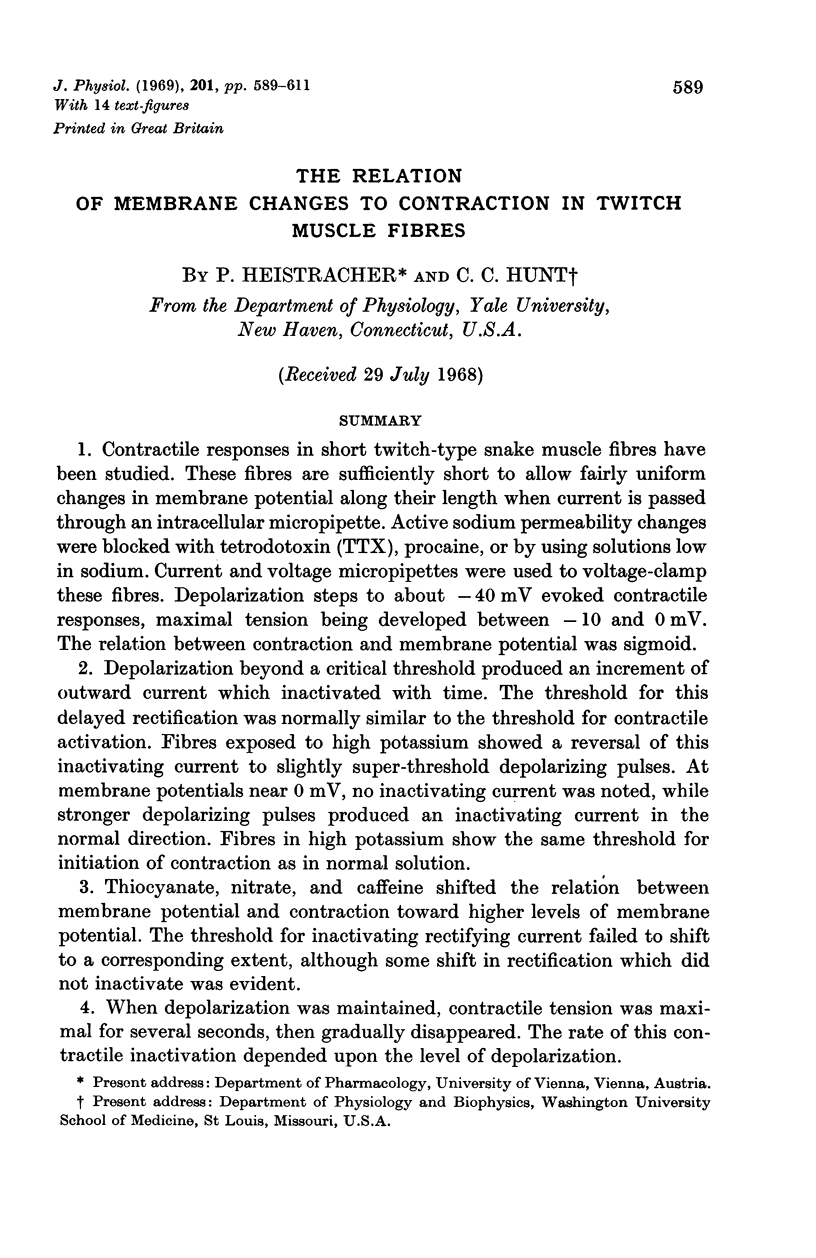
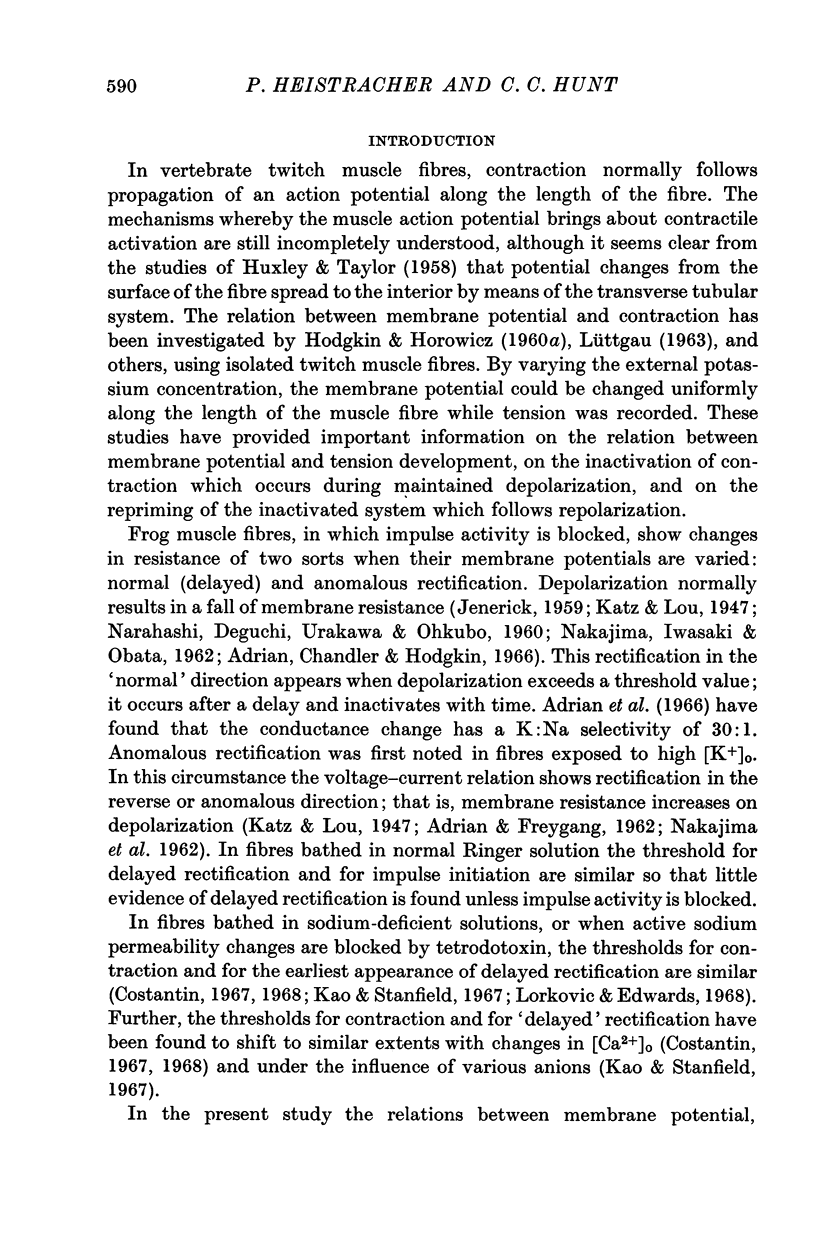
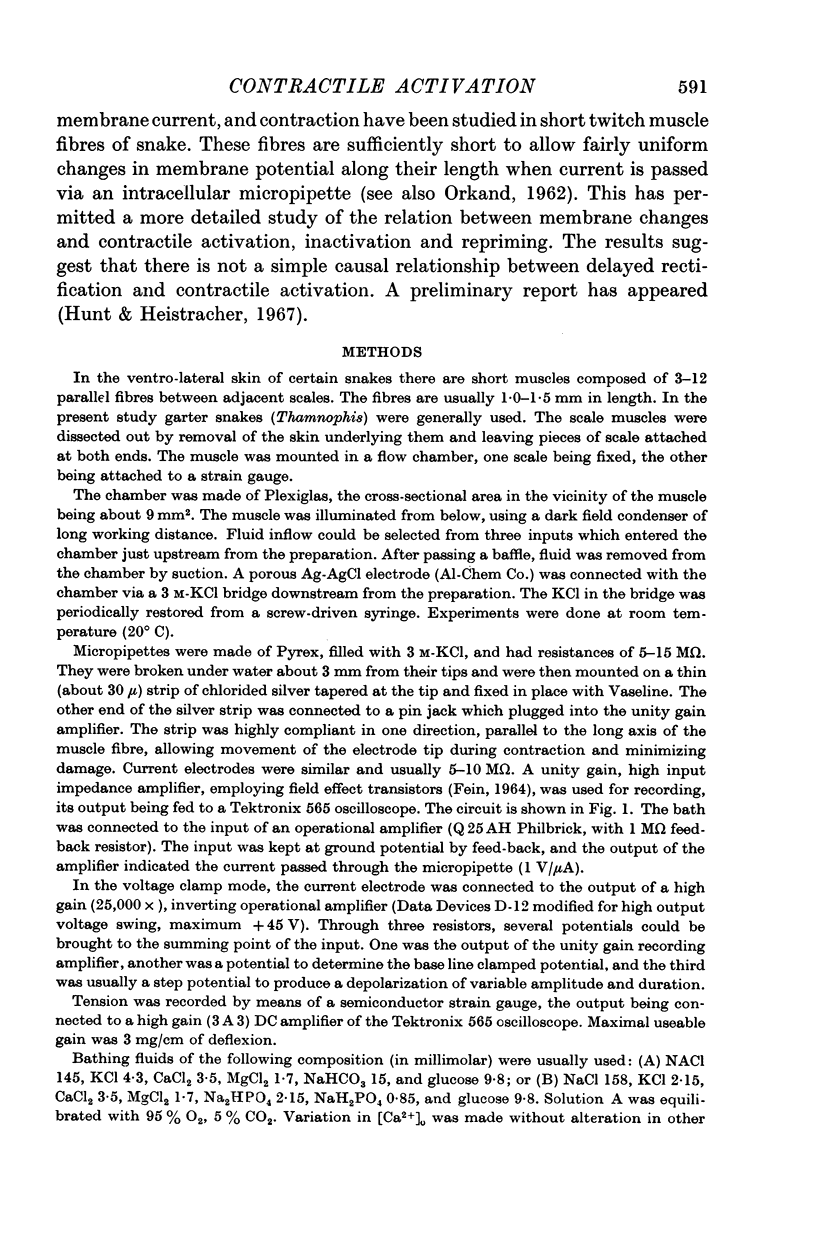
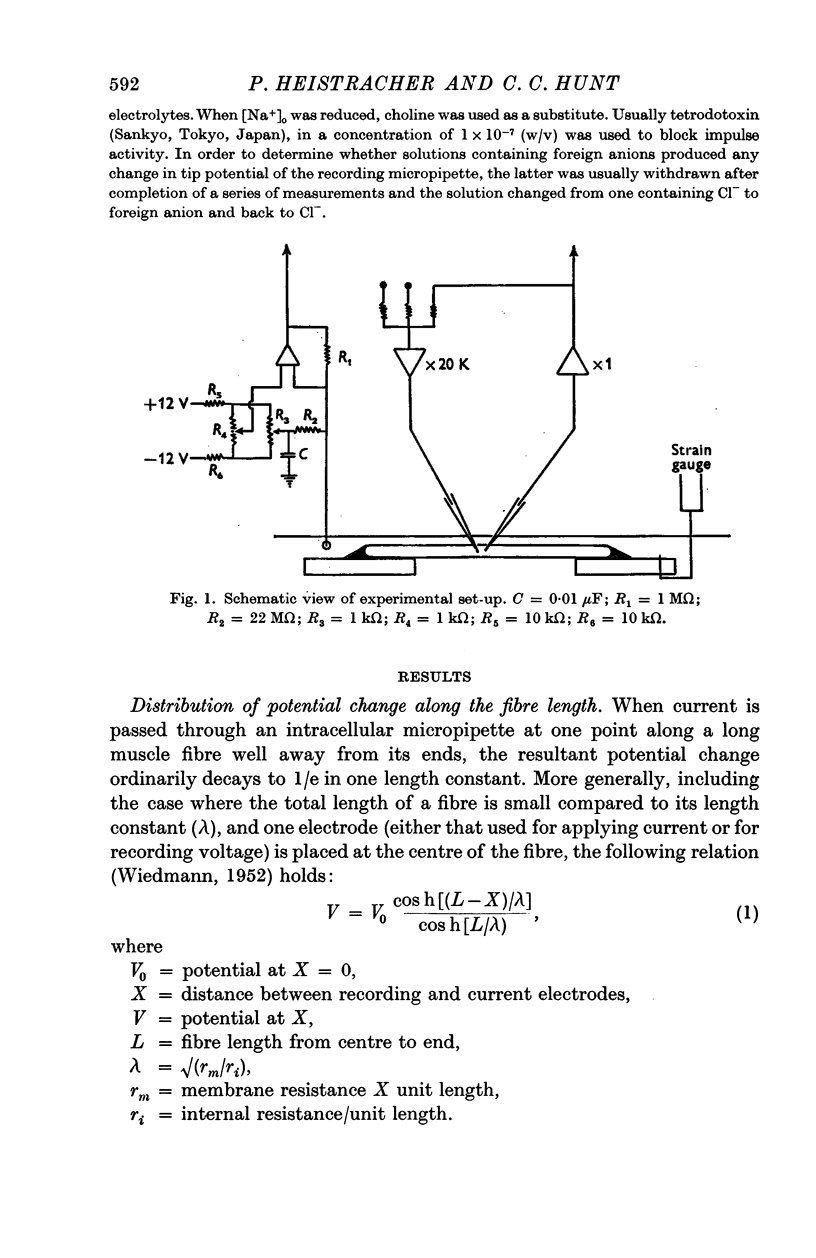
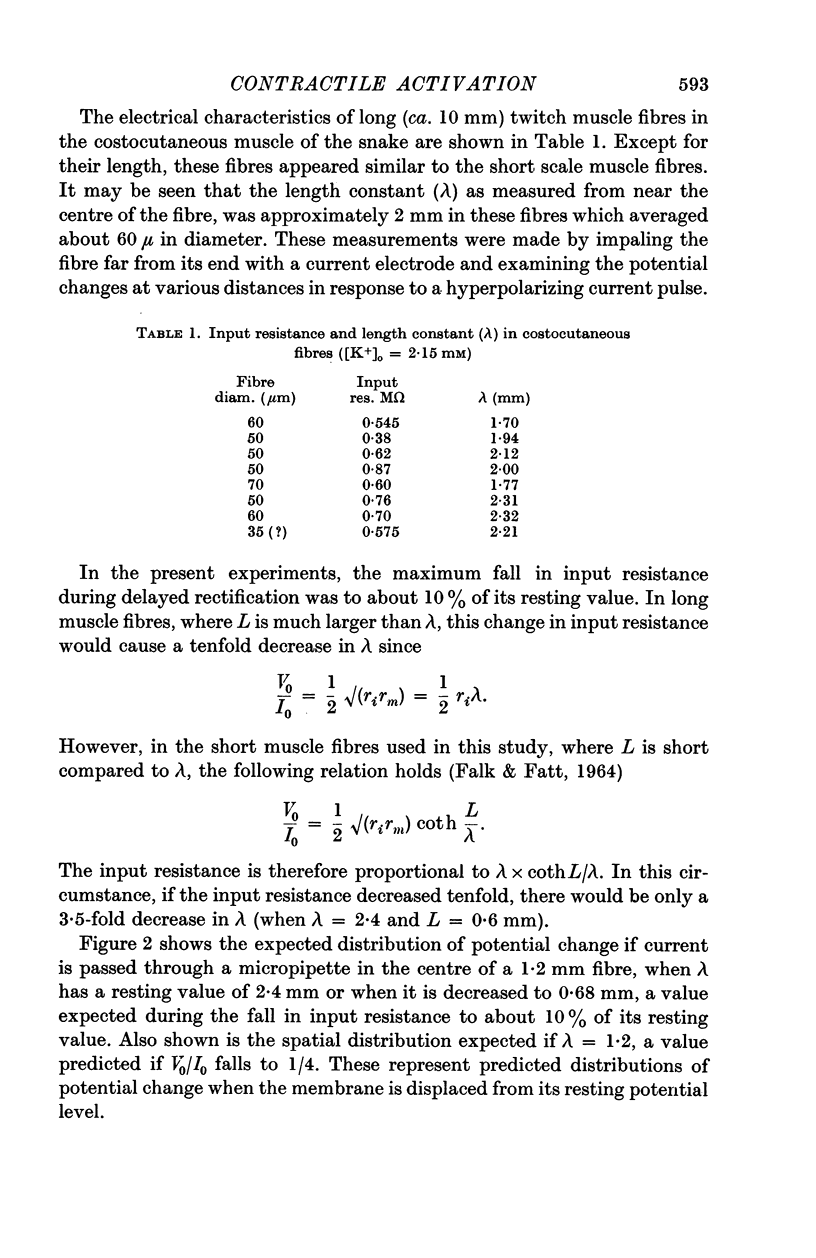
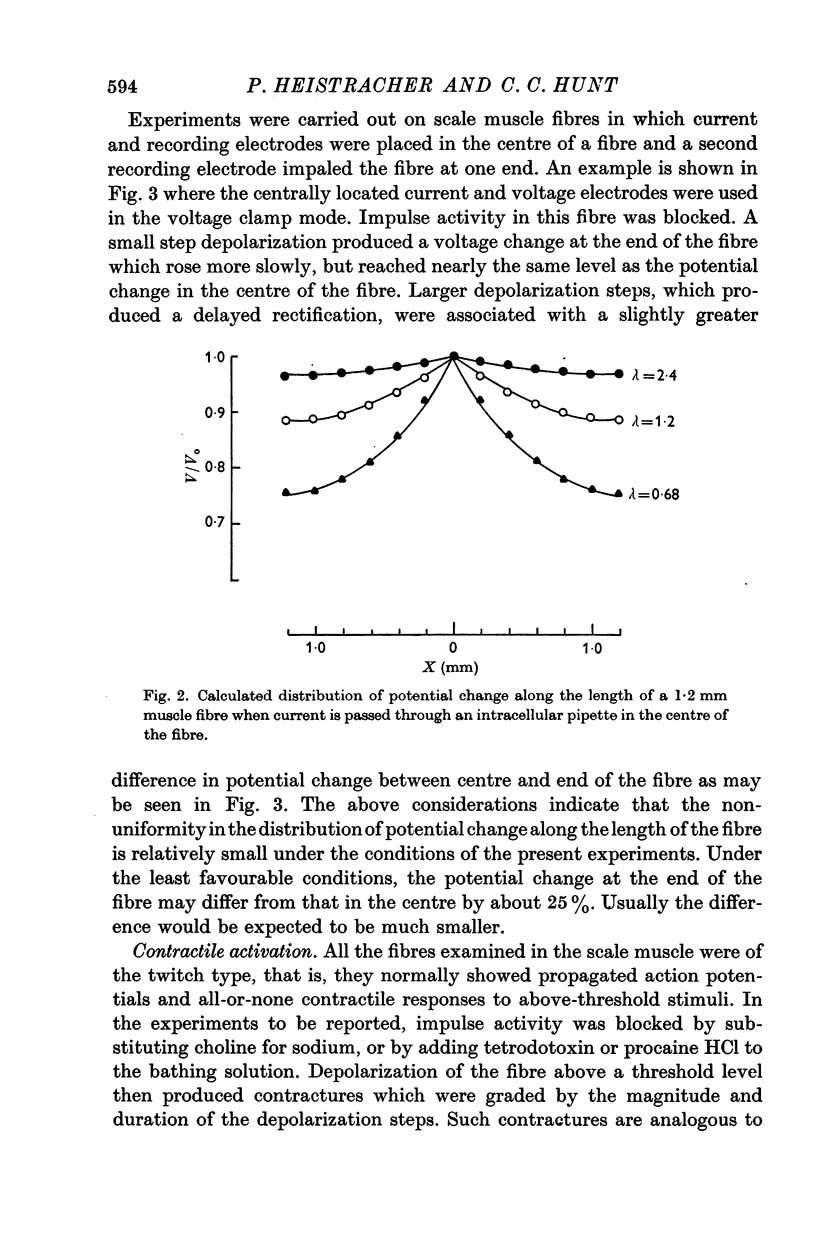
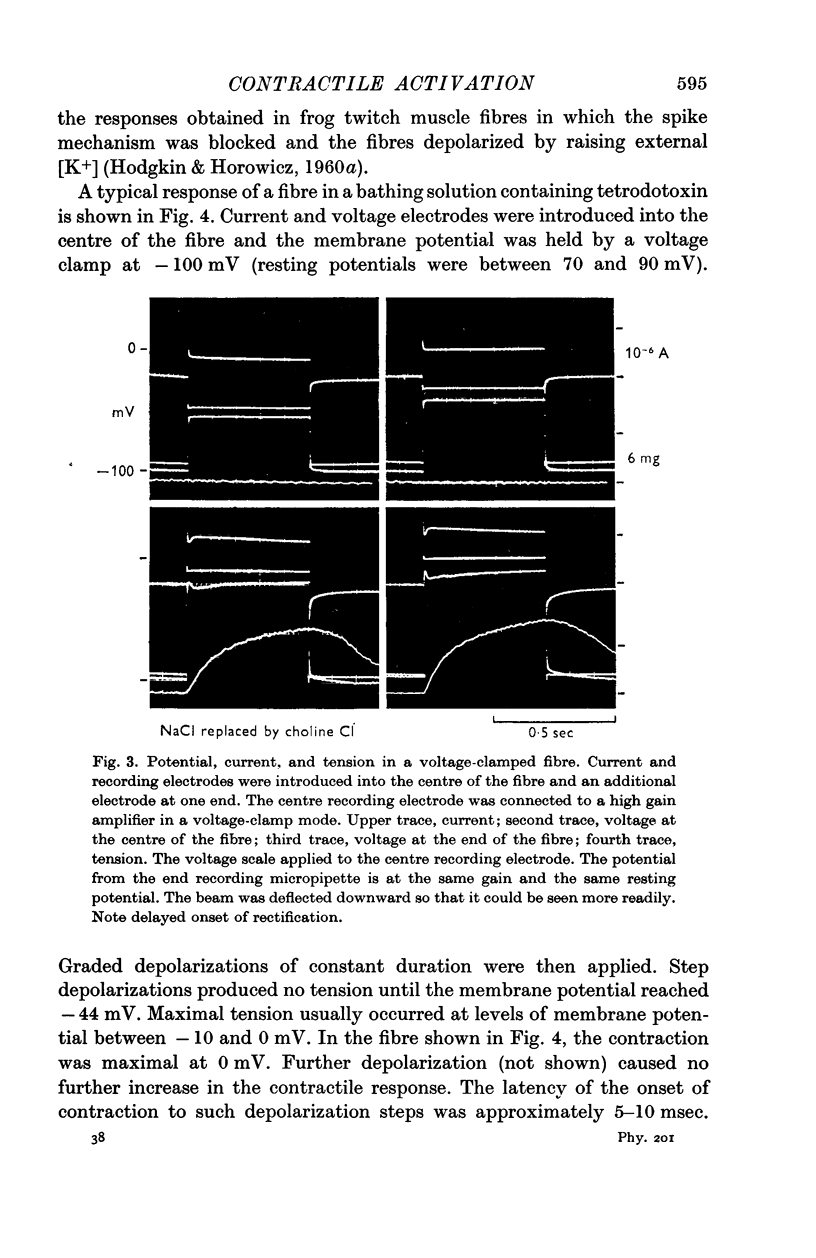
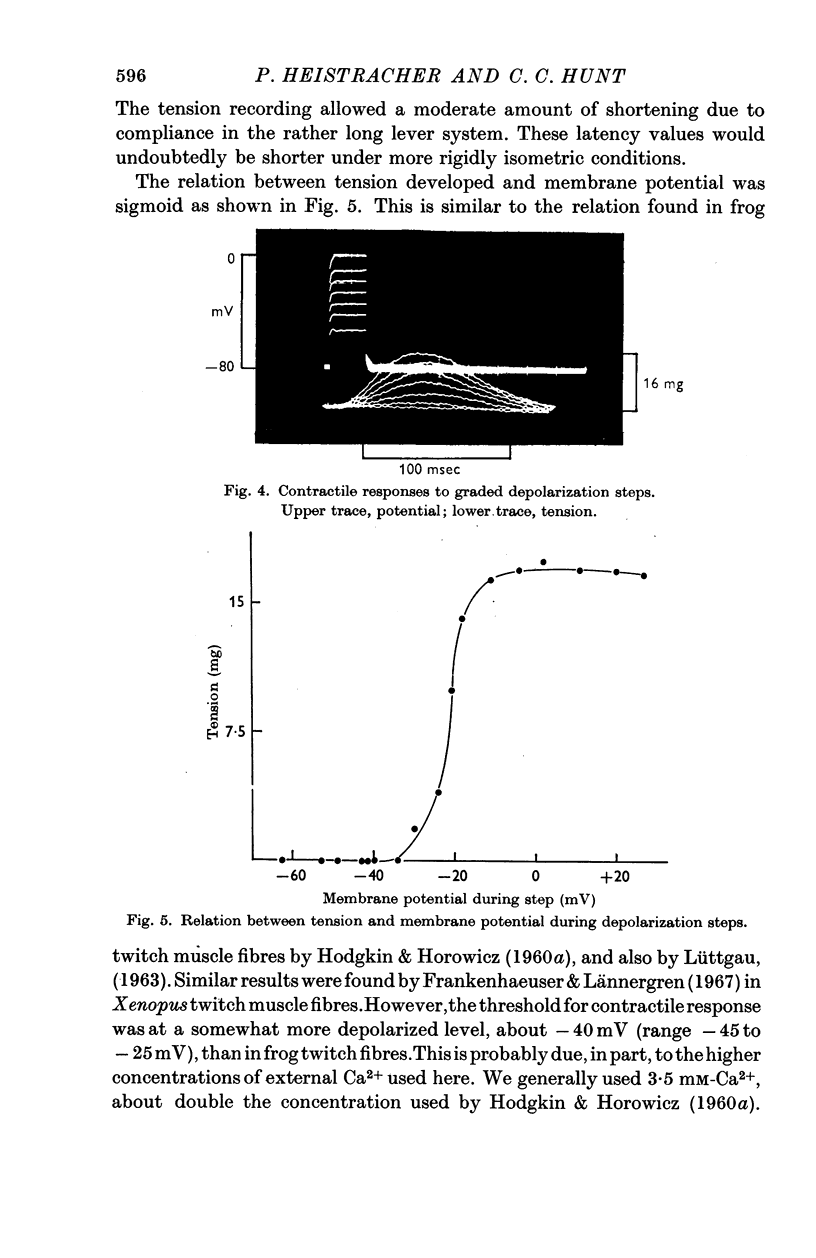
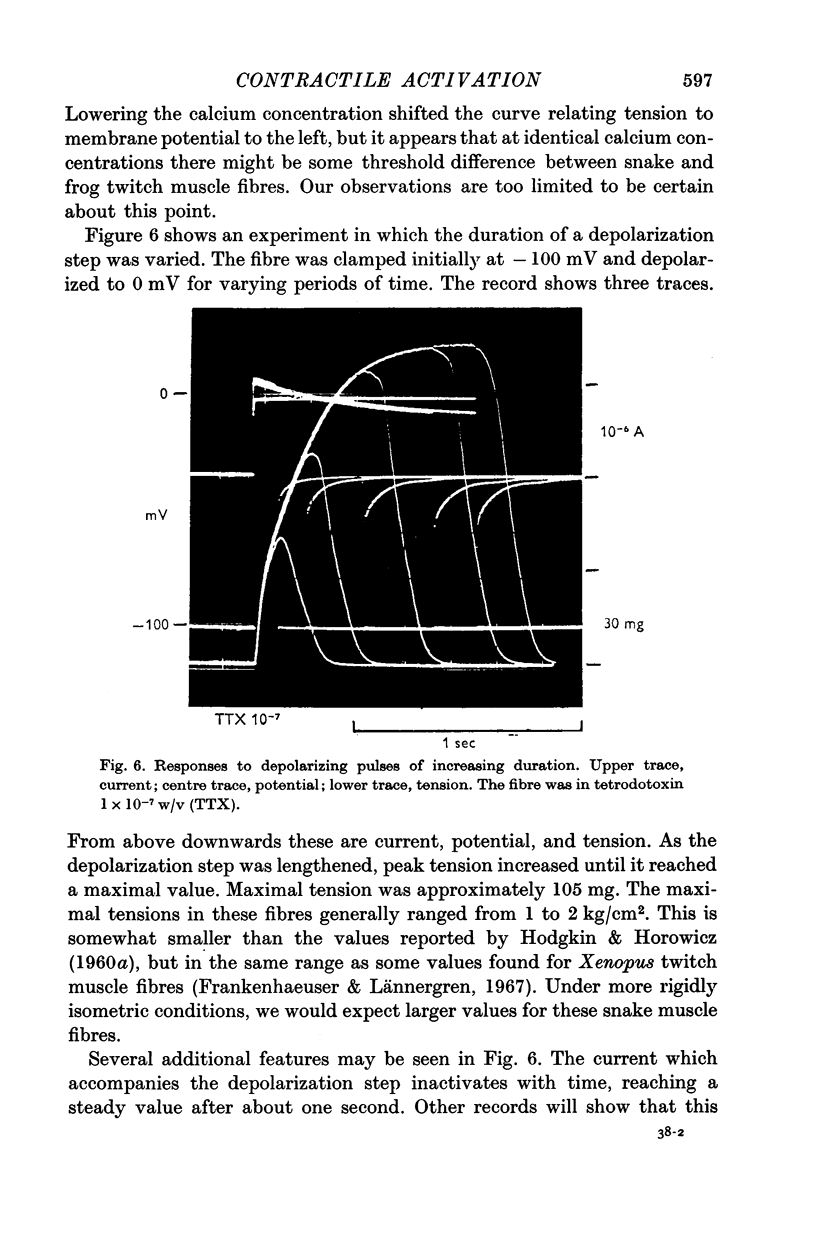
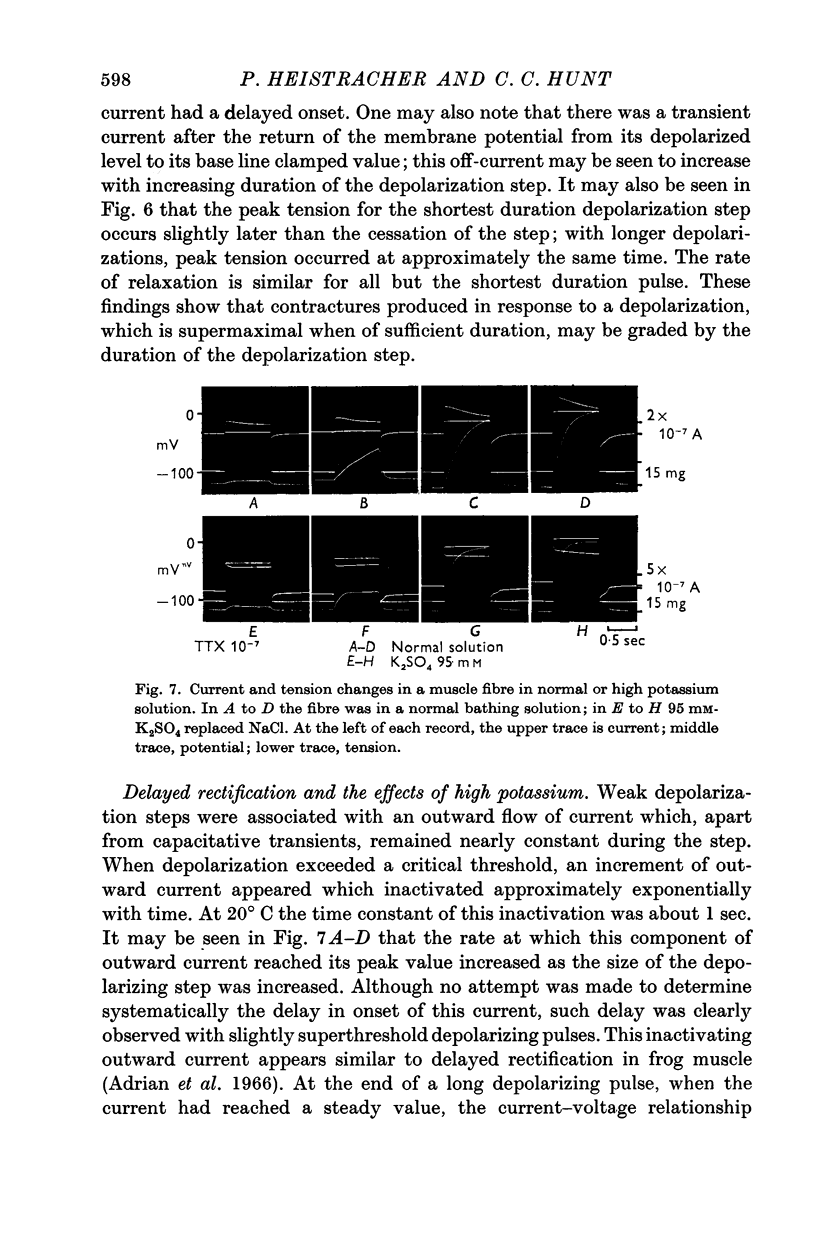
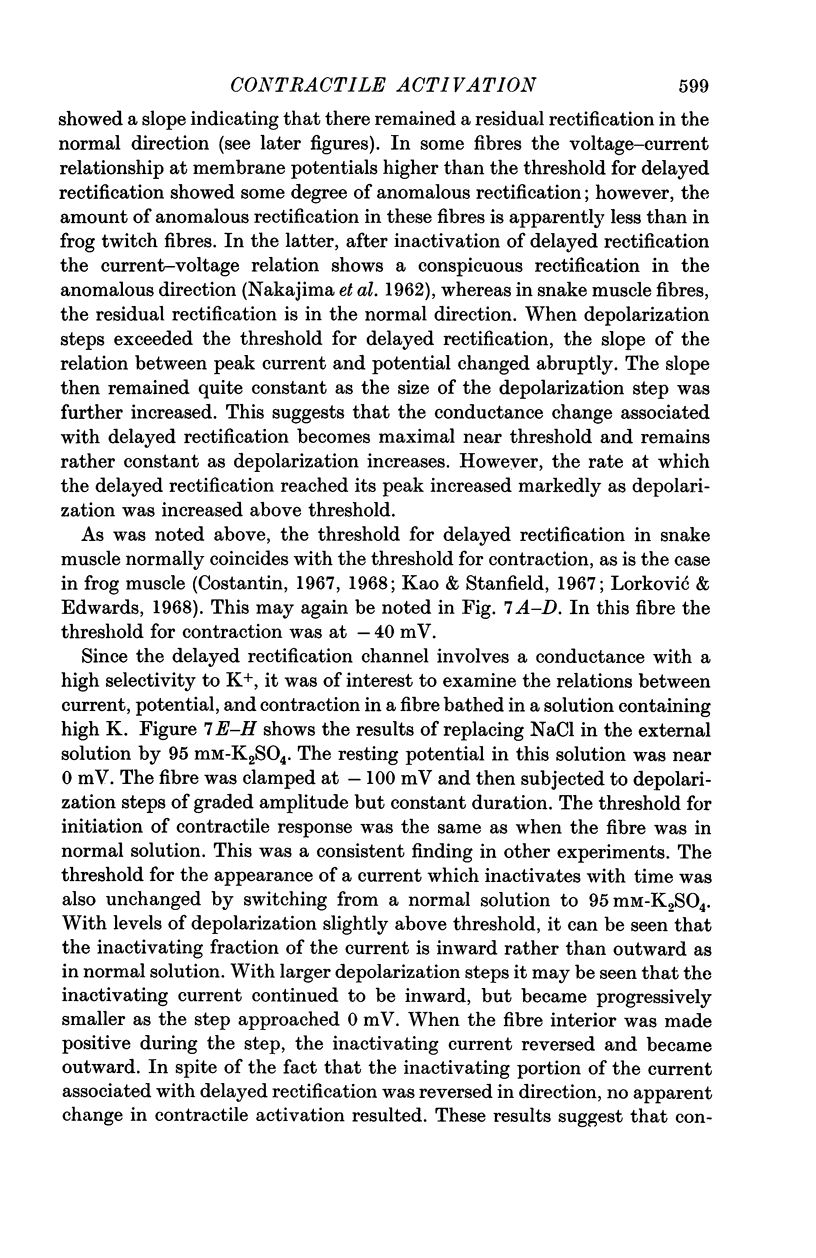
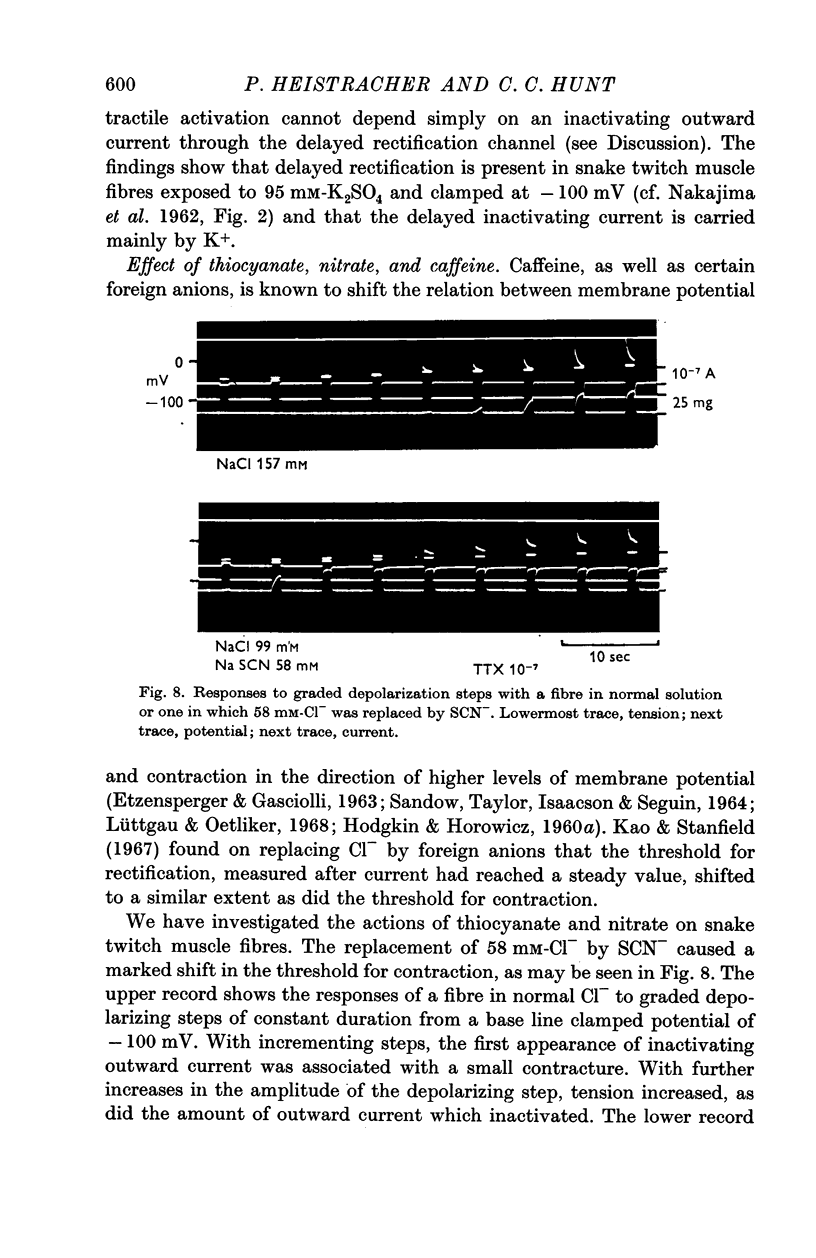
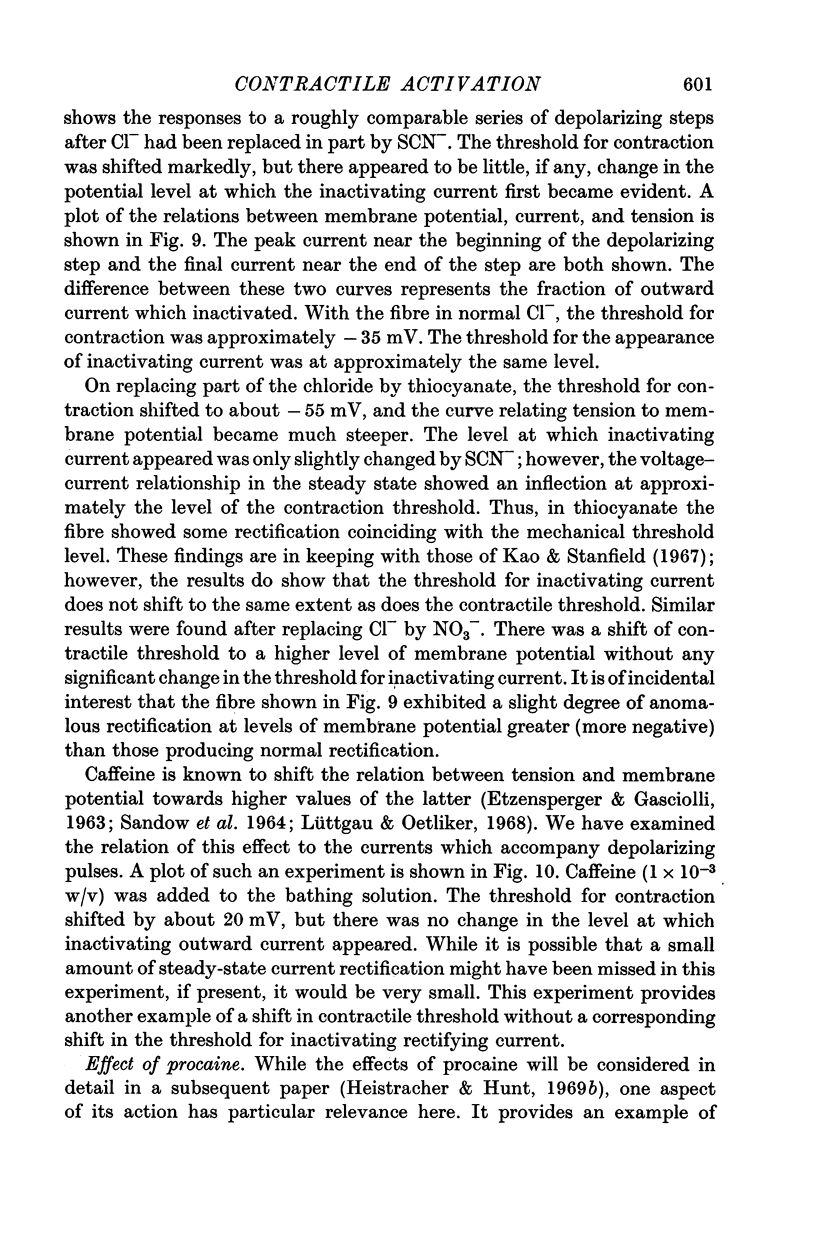
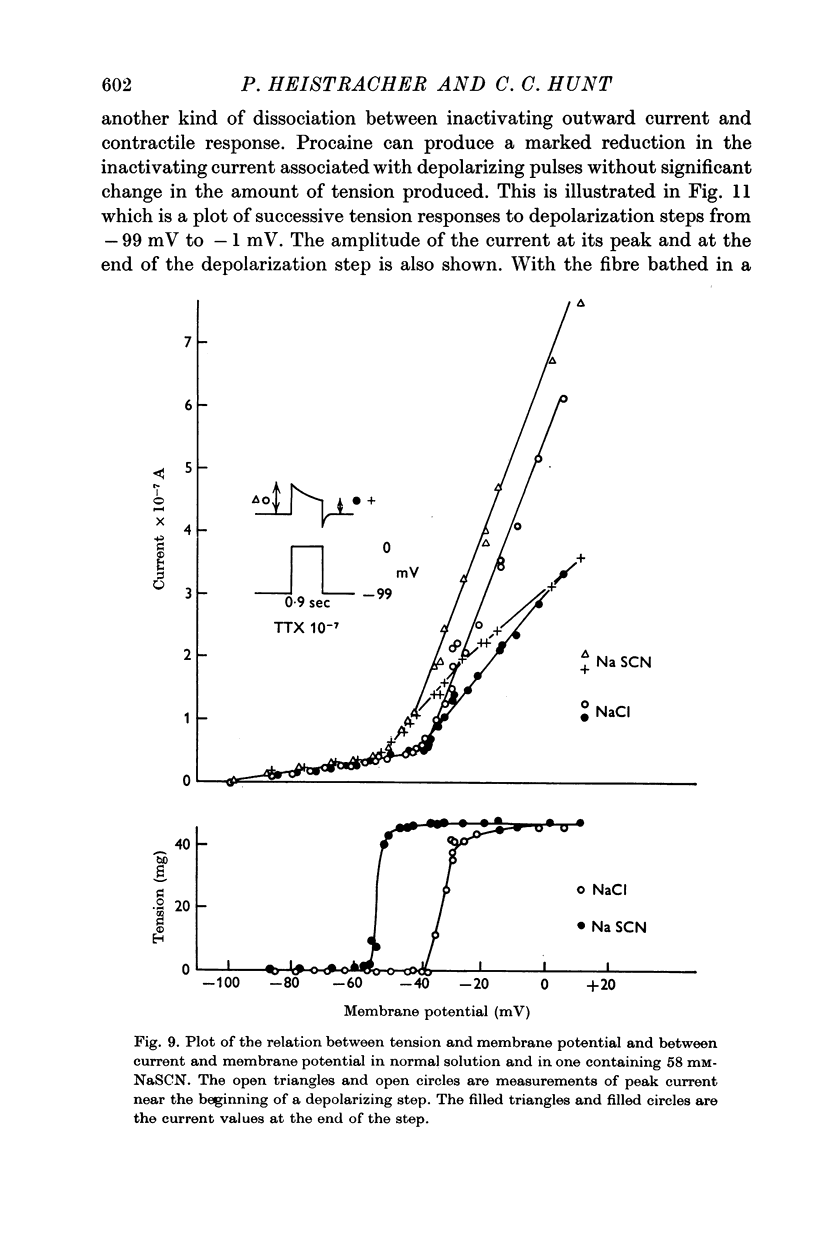
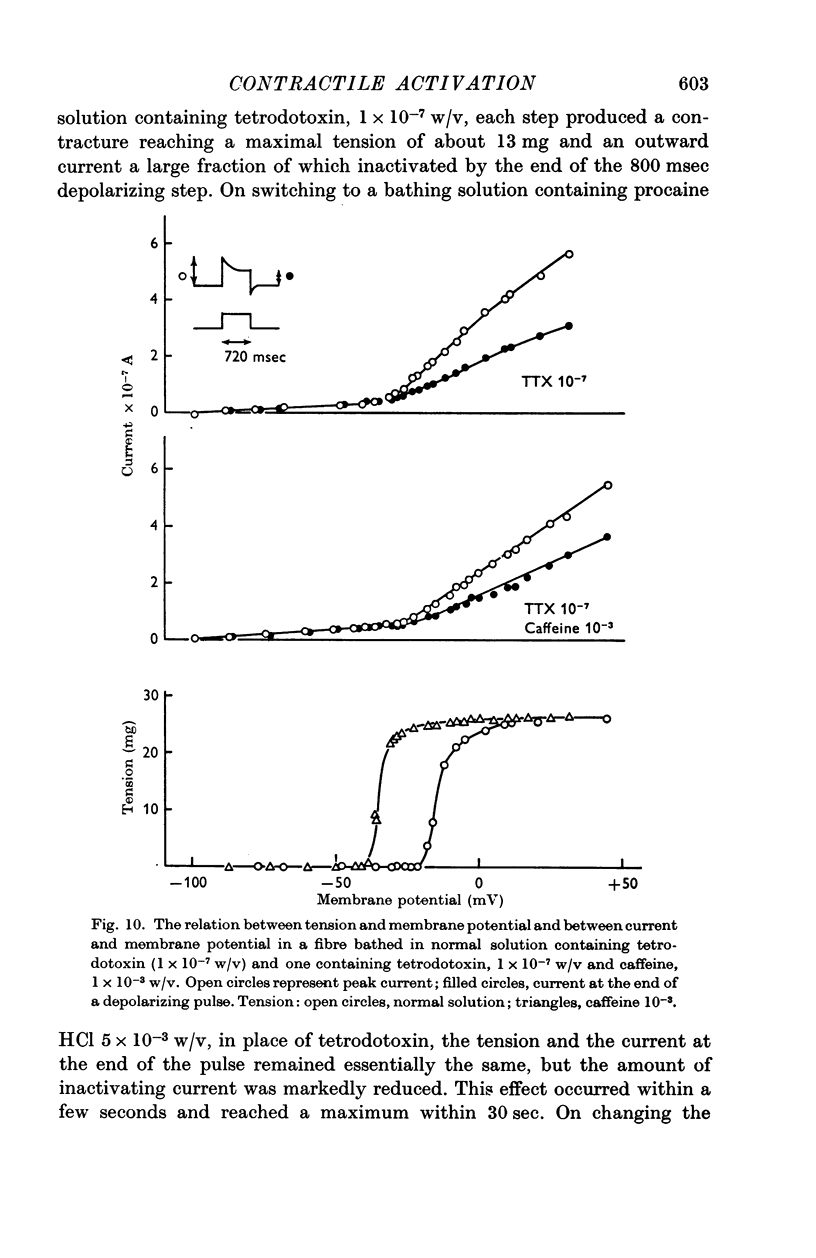
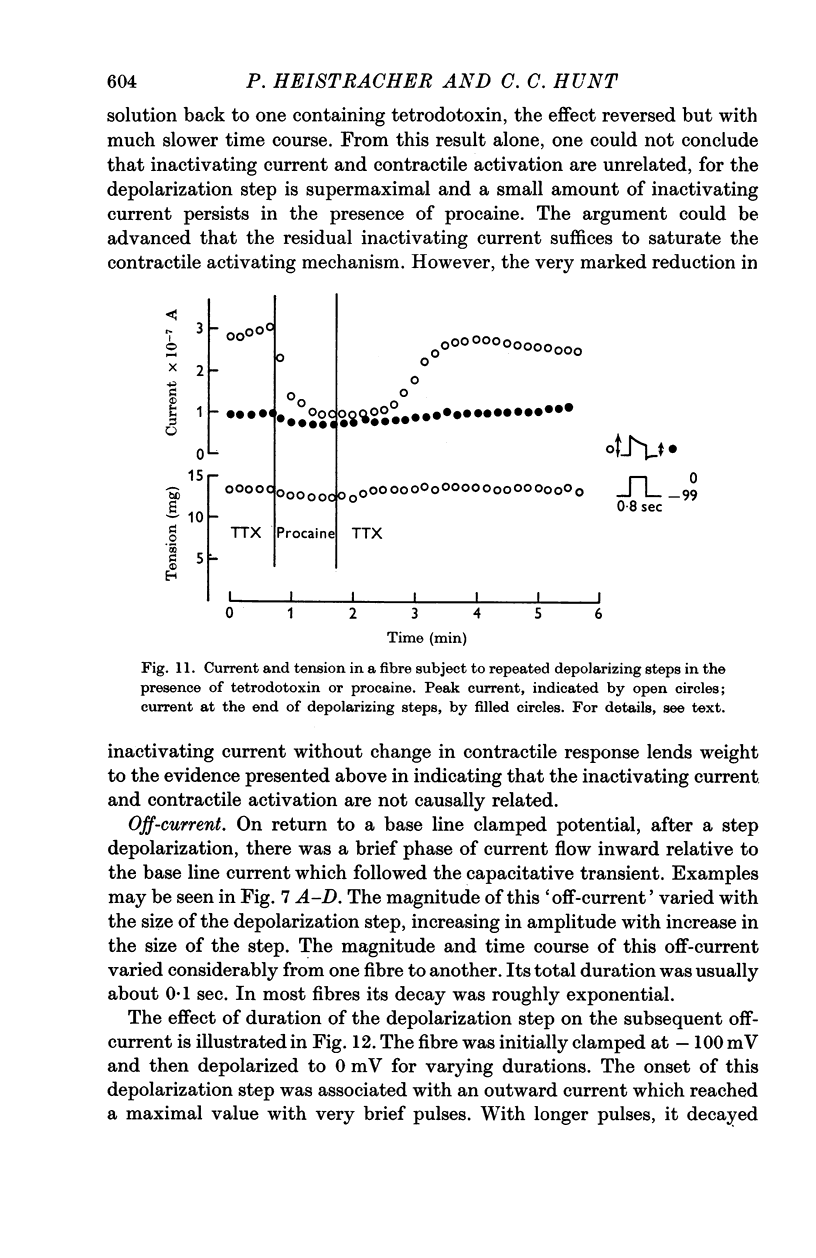
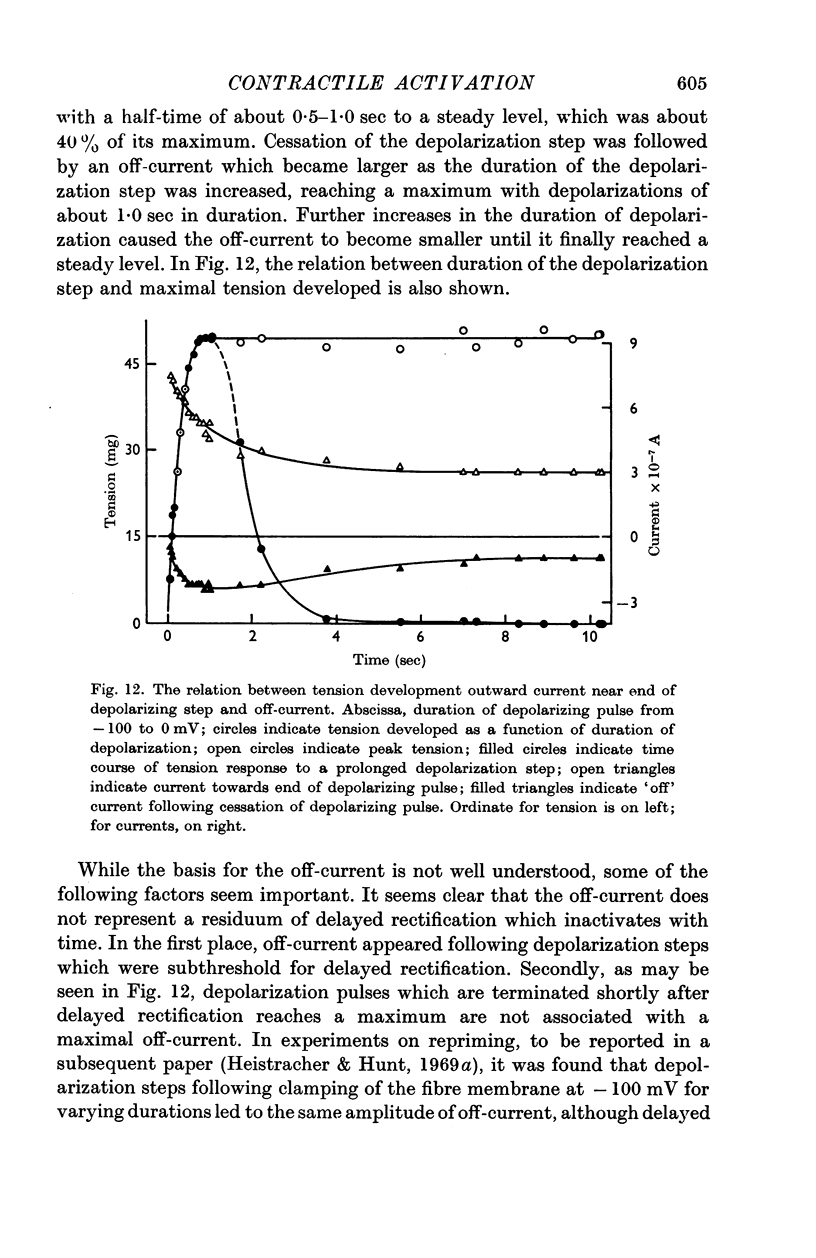
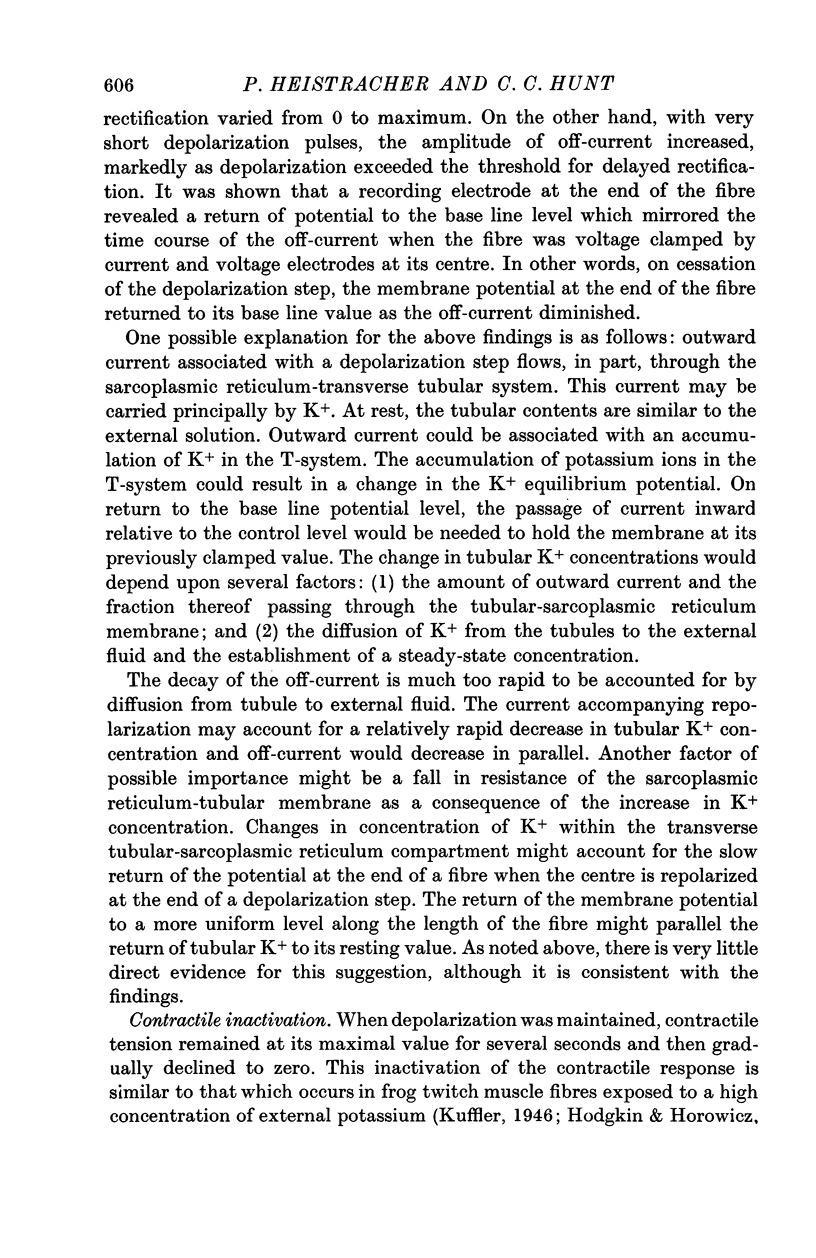
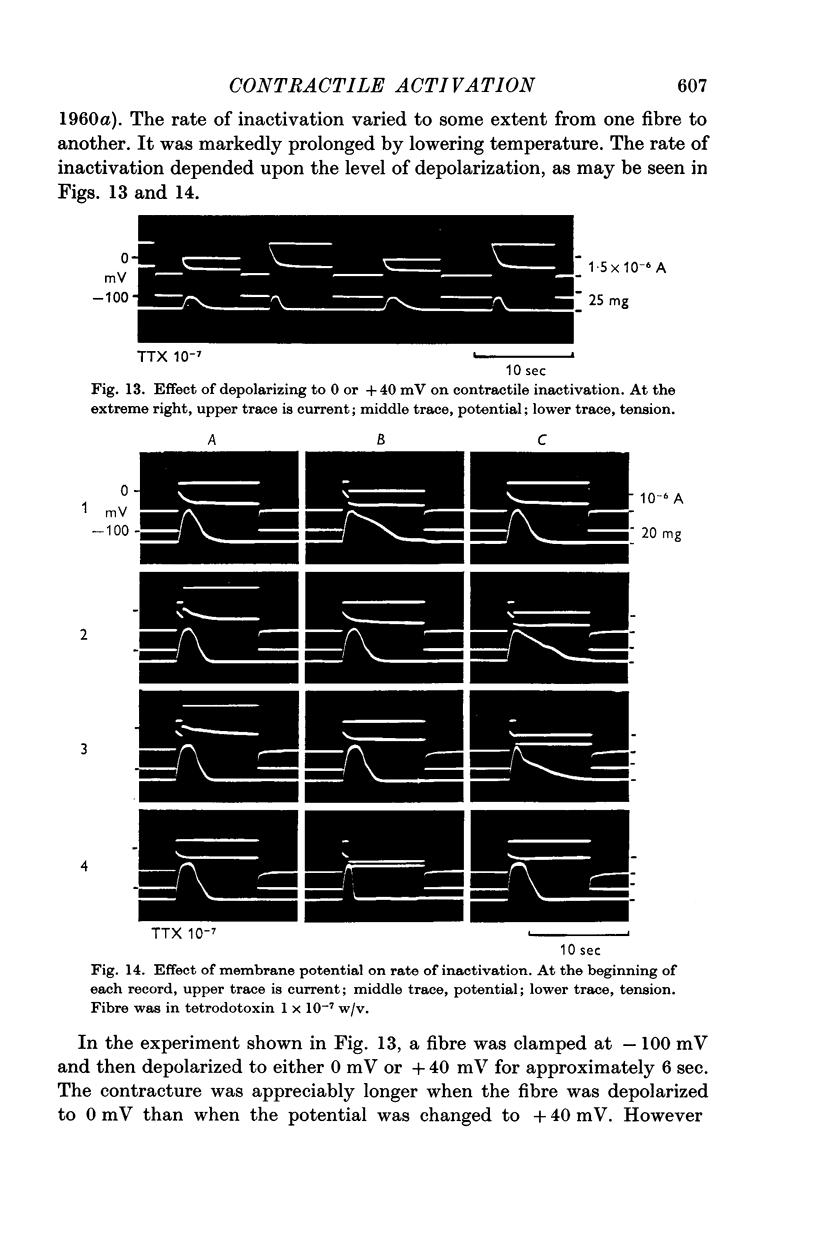
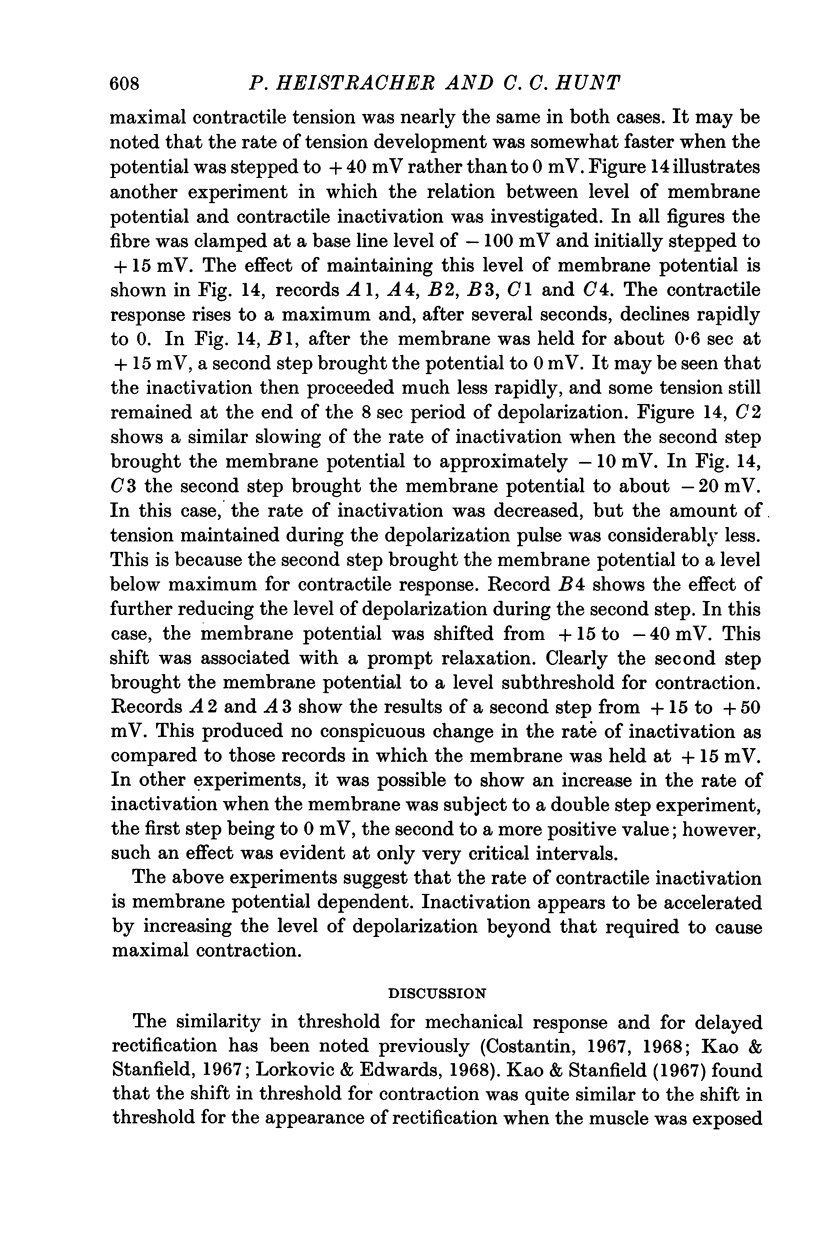
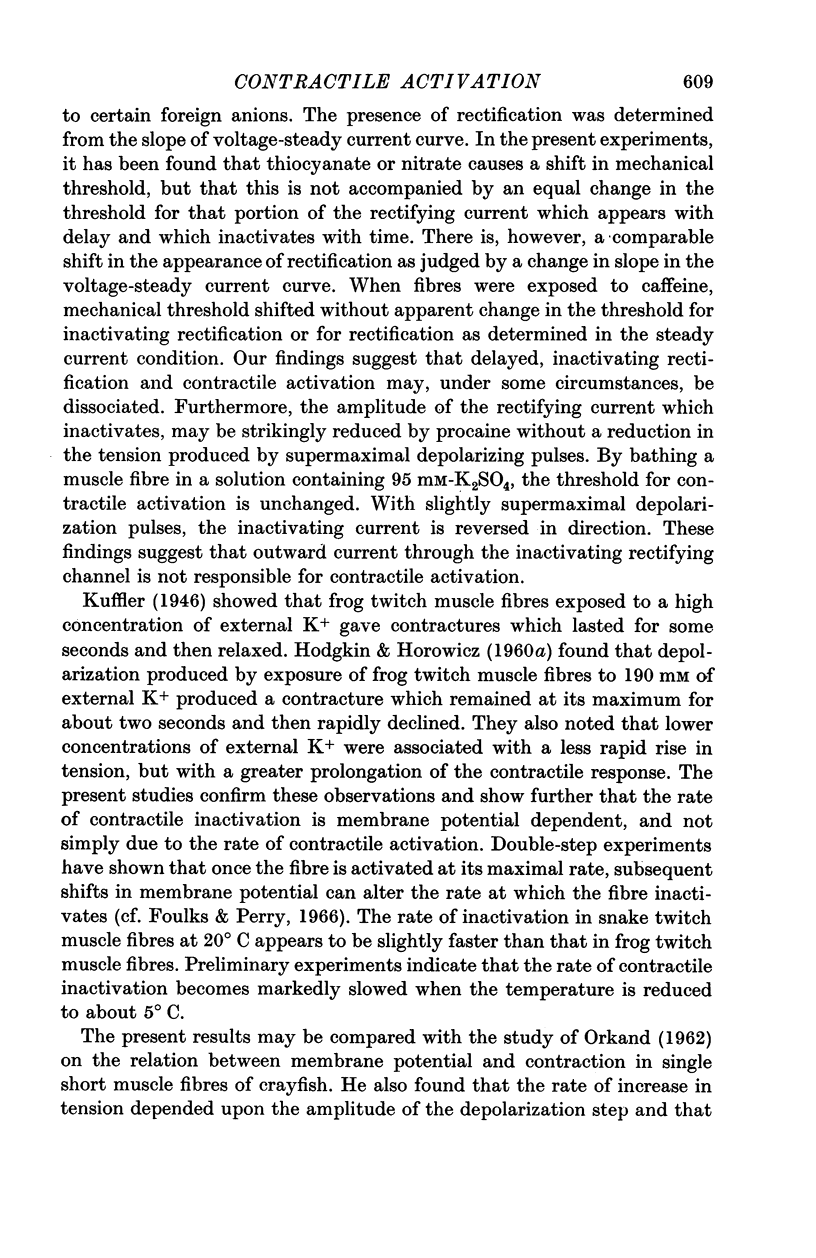
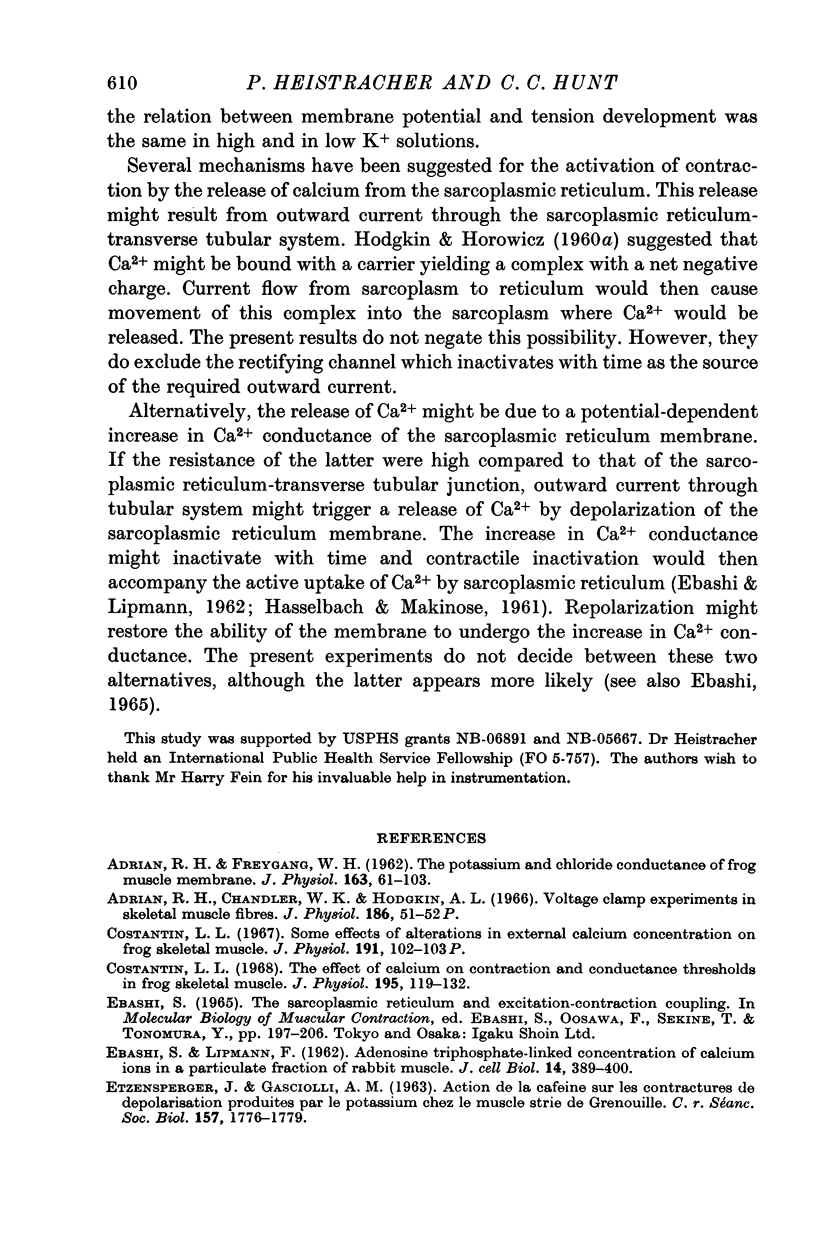
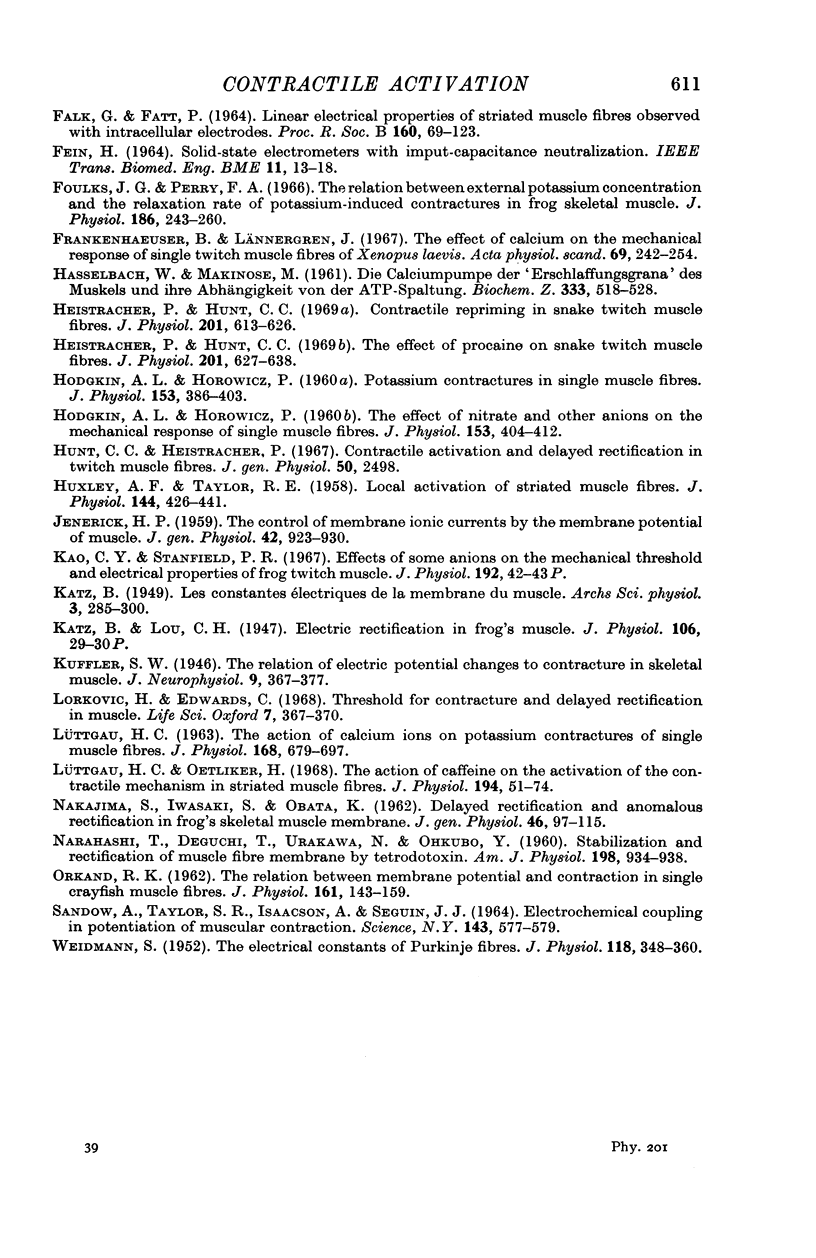
Selected References
These references are in PubMed. This may not be the complete list of references from this article.
- Adrian R. H., Freygang W. H. The potassium and chloride conductance of frog muscle membrane. J Physiol. 1962 Aug;163(1):61–103. doi: 10.1113/jphysiol.1962.sp006959. [DOI] [PMC free article] [PubMed] [Google Scholar]
- Costantin L. L. Some effects of alterations in external calcium concentration on frog skeletal muscle. J Physiol. 1967 Jul;191(2):102P–103P. [PubMed] [Google Scholar]
- Costantin L. L. The effect o f calcium on contraction and conductance thresholds in frog skeletal muscle. J Physiol. 1968 Mar;195(1):119–132. doi: 10.1113/jphysiol.1968.sp008450. [DOI] [PMC free article] [PubMed] [Google Scholar]
- ETZENSPERGER J., GASCIOLLI A. M. ACTION DE LA CAF'EINE SUR LES CONTRACTURES DE D'EPOLARISATION PRODUITES PAR LE POTASSIUM CHEZ LE MUSCLE STRI'E DE GRENOUILLE. C R Seances Soc Biol Fil. 1963;157:1776–1779. [PubMed] [Google Scholar]
- Ebashi S., Lipmann F. ADENOSINE TRIPHOSPHATE-LINKED CONCENTRATION OF CALCIUM IONS IN A PARTICULATE FRACTION OF RABBIT MUSCLE. J Cell Biol. 1962 Sep 1;14(3):389–400. doi: 10.1083/jcb.14.3.389. [DOI] [PMC free article] [PubMed] [Google Scholar]
- FALK G., FATT P. LINEAR ELECTRICAL PROPERTIES OF STRIATED MUSCLE FIBRES OBSERVED WITH INTRACELLULAR ELECTRODES. Proc R Soc Lond B Biol Sci. 1964 Apr 14;160:69–123. doi: 10.1098/rspb.1964.0030. [DOI] [PubMed] [Google Scholar]
- FEIN H. SOLID-STATE ELECTROMETERS WITH INPUT-CAPACITANCE NEUTRALIZATION. IEEE Trans Biomed Eng. 1964 Jan-Apr;11:13–18. doi: 10.1109/tbme.1964.4502292. [DOI] [PubMed] [Google Scholar]
- Foulks J. G., Perry F. A. The relation between external potassium concentration and the relaxation rate of potassium-induced contractures in frog skeletal muscle. J Physiol. 1966 Oct;186(2):243–260. doi: 10.1113/jphysiol.1966.sp008032. [DOI] [PMC free article] [PubMed] [Google Scholar]
- Frankenhaeuser B., Lännergren J. The effect of calcium on the mechanical response of single twitch muscle fibres of Xenopus laevis. Acta Physiol Scand. 1967 Mar;69(3):242–254. doi: 10.1111/j.1748-1716.1967.tb03518.x. [DOI] [PubMed] [Google Scholar]
- HASSELBACH W., MAKINOSE M. [The calcium pump of the "relaxing granules" of muscle and its dependence on ATP-splitting]. Biochem Z. 1961;333:518–528. [PubMed] [Google Scholar]
- HODGKIN A. L., HOROWICZ P. Potassium contractures in single muscle fibres. J Physiol. 1960 Sep;153:386–403. doi: 10.1113/jphysiol.1960.sp006541. [DOI] [PMC free article] [PubMed] [Google Scholar]
- HODGKIN A. L., HOROWICZ P. The effect of nitrate and other anions on the mechanical response of single muscle fibres. J Physiol. 1960 Sep;153:404–412. doi: 10.1113/jphysiol.1960.sp006542. [DOI] [PMC free article] [PubMed] [Google Scholar]
- HUXLEY A. F., TAYLOR R. E. Local activation of striated muscle fibres. J Physiol. 1958 Dec 30;144(3):426–441. doi: 10.1113/jphysiol.1958.sp006111. [DOI] [PMC free article] [PubMed] [Google Scholar]
- Heistracher P., Hunt C. C. Contractile repriming in snake twitch muscle fibres. J Physiol. 1969 May;201(3):613–626. doi: 10.1113/jphysiol.1969.sp008775. [DOI] [PMC free article] [PubMed] [Google Scholar]
- Heistracher P., Hunt C. C. The effect of procaine on snake twitch muscle fibres. J Physiol. 1969 May;201(3):627–638. doi: 10.1113/jphysiol.1969.sp008776. [DOI] [PMC free article] [PubMed] [Google Scholar]
- JENERICK H. The control of membrane ionic currents by the membrane potential of muscle. J Gen Physiol. 1959 May 20;42(5):923–930. doi: 10.1085/jgp.42.5.923. [DOI] [PMC free article] [PubMed] [Google Scholar]
- LUETTGAU H. C. THE ACTION OF CALCIUM IONS ON POTASSIUM CONTRACTURES OF SINGLE MUSCLE FIBRES. J Physiol. 1963 Oct;168:679–697. doi: 10.1113/jphysiol.1963.sp007215. [DOI] [PMC free article] [PubMed] [Google Scholar]
- Lorkovic H., Edwards C. Threshold for contracture and delayed rectification in muscle. Life Sci. 1968 Apr 1;7(7):367–370. doi: 10.1016/0024-3205(68)90005-2. [DOI] [PubMed] [Google Scholar]
- Lüttgau H. C., Oetliker H. The action of caffeine on the activation of the contractile mechanism in straited muscle fibres. J Physiol. 1968 Jan;194(1):51–74. doi: 10.1113/jphysiol.1968.sp008394. [DOI] [PMC free article] [PubMed] [Google Scholar]
- NAKAJIMA S., IWASAKI S., OBATA K. Delayed rectification and anomalous rectification in frog's skeletal muscle membrane. J Gen Physiol. 1962 Sep;46:97–115. doi: 10.1085/jgp.46.1.97. [DOI] [PMC free article] [PubMed] [Google Scholar]
- NARAHASHI T., DEGUCHI T., URAKAWA N., OHKUBO Y. Stabilization and rectification of muscle fiber membrane by tetrodotoxin. Am J Physiol. 1960 May;198:934–938. doi: 10.1152/ajplegacy.1960.198.5.934. [DOI] [PubMed] [Google Scholar]
- ORKAND R. K. The relation between membrane potential and contraction in single crayfish muscle fibres. J Physiol. 1962 Apr;161:143–159. doi: 10.1113/jphysiol.1962.sp006878. [DOI] [PMC free article] [PubMed] [Google Scholar]
- SANDOW A., TAYLOR S. R., ISAASON A., SEGUIN J. J. ELECTROCHEMICAL COUPLING IN POTENTIATION OF MUSCULAR CONTRACTION. Science. 1964 Feb 7;143(3606):577–579. doi: 10.1126/science.143.3606.577. [DOI] [PubMed] [Google Scholar]
- WEIDMANN S. The electrical constants of Purkinje fibres. J Physiol. 1952 Nov;118(3):348–360. doi: 10.1113/jphysiol.1952.sp004799. [DOI] [PMC free article] [PubMed] [Google Scholar]


